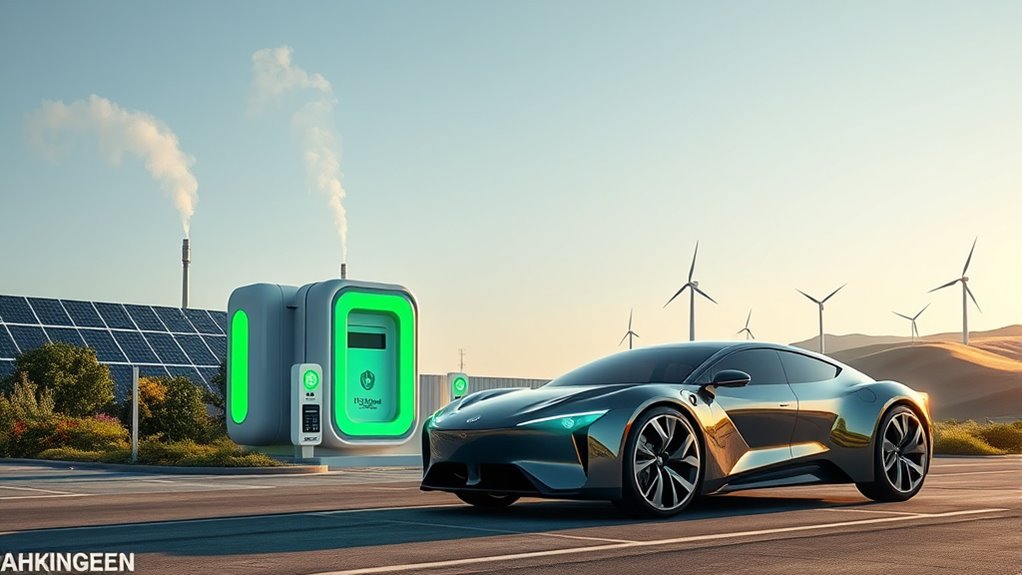Yes, green hydrogen is finally becoming a viable and scalable energy solution. Advances in renewable infrastructure, such as solar and wind power, reduce production costs, while supportive policies like subsidies and tax incentives encourage industry adoption. These developments create a strong foundation for widespread use, making green hydrogen competitive with fossil fuels. If you want to explore how these factors work together to shape Hydrogen Economy 2.0, you’ll find some interesting insights ahead.
Key Takeaways
- Increasing renewable infrastructure reduces green hydrogen production costs and enhances scalability.
- Policy incentives like subsidies and tax credits accelerate adoption and project financing.
- Advancements in electrolysis technology and storage solutions improve efficiency and reliability.
- Growing infrastructure, such as refueling stations, supports wider use in transportation and industry.
- Strong industry and government commitment is driving the transition toward commercial-scale green hydrogen.

As the world accelerates its shift toward sustainable energy, Hydrogen Economy 2.0 emerges as a revolutionary step forward. This new phase isn’t just about producing hydrogen; it’s about creating a thorough, efficient system that can power industries, transportation, and homes with clean energy. Central to this transformation is the development of renewable infrastructure. You’ll see that building a robust network of renewable energy sources—solar farms, wind turbines, and hydroelectric plants—is essential for producing green hydrogen at scale. These facilities generate the electricity needed for electrolysis, splitting water into hydrogen and oxygen without emitting greenhouse gases. Without this renewable infrastructure, hydrogen remains tied to fossil fuels, undermining its potential as a clean energy carrier.
Building renewable infrastructure is essential for scalable, clean hydrogen production and a sustainable energy future.
Policy incentives play a pivotal role in accelerating this progress. Governments around the world are recognizing the importance of supporting green hydrogen through subsidies, tax credits, and regulatory frameworks. If you’re involved in planning or investment, these policy incentives can considerably reduce costs and mitigate risks, making projects more financially viable. They’re designed to encourage the adoption of renewable energy sources and the deployment of electrolysis technology, fostering a fertile environment for innovation and growth. When policy incentives are aligned with industry needs, they can quicken the transition from pilot projects to large-scale adoption, ensuring green hydrogen becomes a mainstream energy solution sooner rather than later.
The integration of renewable infrastructure and policy incentives creates a feedback loop that accelerates progress. As more renewable facilities come online, the cost of producing green hydrogen drops, making it more competitive with fossil fuels. Meanwhile, policy incentives help bridge the gap in initial investments, incentivizing companies and governments to prioritize green hydrogen projects. If you’re looking to capitalize on this shift, understanding these drivers is essential. They determine where investments are most likely to succeed and how quickly green hydrogen can reach commercial viability.
Furthermore, this synergy supports the development of specialized infrastructure, like hydrogen refueling stations and storage facilities, which are critical for expanding hydrogen’s use in transportation and industry. It also encourages research and innovation, leading to more efficient electrolysis methods and better storage solutions. By actively participating in this evolving landscape, you can help shape policies and infrastructure development that remove barriers and promote widespread adoption. The future of green hydrogen hinges on these foundational elements—renewable infrastructure and strong policy incentives—working hand in hand to make Hydrogen Economy 2.0 a reality.
Frequently Asked Questions
What Are the Main Challenges in Scaling Green Hydrogen Production?
Scaling green hydrogen production faces several hurdles. You’ll encounter storage challenges because hydrogen is tricky to store safely and efficiently. Policy barriers also slow progress, as inconsistent regulations and lack of incentives hinder investment. Overcoming these issues requires coordinated efforts to develop better storage solutions and create supportive policies. Once these challenges are addressed, green hydrogen can become a truly viable and scalable clean energy source for your future needs.
How Does Green Hydrogen Compare Cost-Wise to Fossil Fuels?
Did you know green hydrogen currently costs about $3 to $6 per kilogram, compared to fossil fuels like natural gas at around $2? This cost comparison impacts market viability, making green hydrogen less competitive today. However, as production scales up and renewable energy prices fall, green hydrogen’s costs are expected to drop, improving its market position and long-term viability against traditional fossil fuels.
What Infrastructure Is Needed for Widespread Green Hydrogen Adoption?
To adopt green hydrogen widely, you’ll need robust infrastructure, including efficient hydrogen storage solutions to keep it safe and stable. You also require extensive distribution networks to deliver it from production sites to end users. Building these systems involves upgrading pipelines, fueling stations, and storage facilities. This infrastructure will make green hydrogen more accessible, supporting a cleaner energy future and enabling you to seamlessly integrate it into transportation, industry, and power generation.
Are There Any Environmental Risks Associated With Green Hydrogen?
You might wonder about the environmental impact of green hydrogen. While it produces zero emissions during use, its production can cause ecosystem disruption if not managed properly. Large-scale water electrolysis requires significant water resources, which could strain local ecosystems. However, compared to fossil fuels, green hydrogen offers a cleaner alternative, reducing air pollution and greenhouse gases. Proper regulation and sustainable practices are key to minimizing environmental risks.
How Soon Could Green Hydrogen Become a Mainstream Energy Source?
Like the dawn of a new era, green hydrogen’s mainstream adoption depends on rapid technological breakthroughs and strong policy incentives. You could see significant use within the next decade if these factors align, as governments and industries invest in infrastructure and innovation. While it’s not an overnight transformation, steady progress suggests green hydrogen could become a crucial energy source sooner than many expect, shaping a cleaner, more sustainable future.
Conclusion
Now, as you stand on the brink of Hydrogen Economy 2.0, it’s clear green hydrogen is finally making waves—think of it as the Renaissance of clean energy. With advancements accelerating faster than a satellite launch, you can’t afford to ignore its potential. The future’s not just a sci-fi flick; it’s happening now, and if you blink, you might miss the train to a greener world. Embrace the change—this is your moment to ride the wave.










